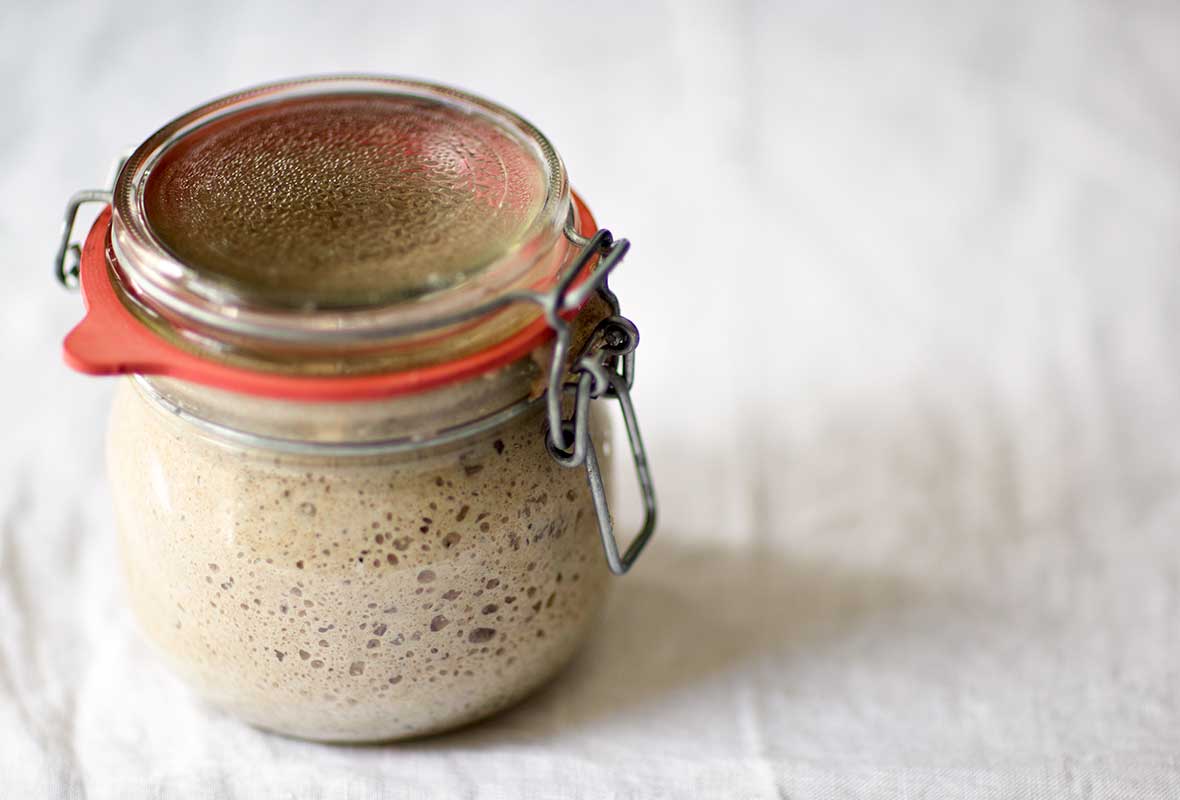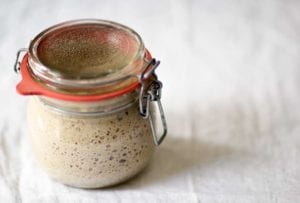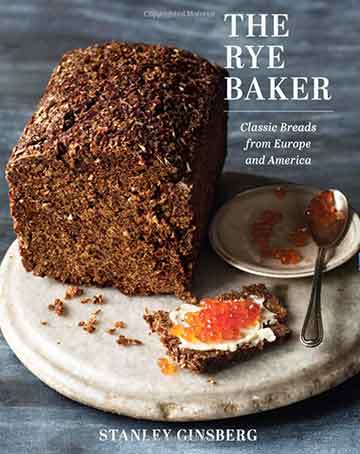
It’s not hard to make a rye sourdough starter from scratch. Some sourdough starters rely on wild yeasts that live in the air, others on acid-producing bacteria present in buttermilk, yogurt, pineapple juice, and the like, and still others start with commercial yeast or store-bought starters. Fact is, none of these additives is necessary. All it really takes to build a delicious and robust rye sour culture, or starter, is some whole-grain rye flour, water, a warm place, and patience. [Editor’s Note: And when your traditional rye sourdough starter is complete, the very first thing you’re going to want to do is use it to make this Galician rye bread.]–Stanley Ginsberg
☞ LEARN MORE, READ: HOW TO DRY SOURDOUGH STARTER

Rye Sourdough Starter
Ingredients
Day 1: Make the Rye Sourdough Starter
- 2.5 ounces whole grain rye flour, preferably organic
- 2.5 ounces warm water (105°F or 41°C)
Days 2 to 7: Refresh the Rye Sourdough Starter
- 2.5 ounces whole grain rye flour, preferably organic
- 2.5 ounces warm water (105°F or 41°C)
- 2.5 ounces Sour Starter from the preceding day
Days 8 and Beyond: Maintain the Rye Sourdough Starter
- 2.5 ounces medium or whole-grain rye flour, preferably organic
- 2.5 ounces warm water (105°F or 41°C)
- .25 ounces rye sourdough starter
Instructions
Day 1: Make the rye sourdough starter
- Start with equal amounts of organic rye flour and water by weight. Dump them in a nonreactive (glass, porcelain, stainless-steel, plastic) container, mix by hand into a stiff paste, cover, and let stand at room temperature (68 to 72°F or 20 to 22°C) for 24 hours.
☞ TESTER TIP: Occasionally the yeast normally present in whole grains fail to establish itself in a new culture; if, after 3 or 4 days, the culture darkens, develops a mold, or smells bad, dump the whole batch and start over. After a week, the culture, or sourdough starter, will be ready to use or to be stored refrigerated in an airtight container for a couple days. [Editor's Note: If storing the sourdough starter for more than a couple days, you'll need to maintain it, which we explain how to do just below.]
Days 2 to 7: Refresh the rye sourdough starter
- The next day, discard all but 2 1/2 ounces (70 grams) of the culture and mix the remainder with the refresh ingredients, cover, and let stand. Repeat each day, discarding all but 2 1/2 ounces (70 grams) of the preceding day’s culture.
☞ TESTER TIP: The most important point to remember at the early stages is to feed the sourdough starter daily. Even when it shows no apparent fermentation, the yeast is busy multiplying and consuming nutrients at a very high rate. By the second or third day, it will swell, show bubbles, and give off a clean sour smell. Over the next few days the activity will become more and more vigorous and the smell more intense.
Days 8 and Beyond: Maintain the rye sourdough starter
- In a perfect world—or in a working bakery—sourdough starters are refreshed daily. That said, daily feedings demand both a degree of dedication and abundant flour supplies that are impractical for all but the most committed home bakers. You can get by refreshing your starter every 36 hours or so.
- Mix the rye flour, water, and rye sourdough starter by hand until incorporated. Cover and ferment at room temperature (68 to 72°F or 20 to 22°C) overnight or for 10 to 12 hours. The sponge will be very bubbly, have a clean sour smell, and will have tripled in volume. Store refrigerated in an airtight container and it will last indefinitely.

Nutrition
Nutrition information is automatically calculated, so should only be used as an approximation.
Recipe Testers’ Reviews
The rye starter was easy to make and quick. It took about 5 minutes each of the 7 days. Mine smelled great and seemed consistent after the week of feedings. I switched to the refresh amounts after that and it stayed nice and healthy.
During the buildup, you end up tossing about 2/3 of it away. I definitely recommend a scale versus just using volume measurements.










Hi,
I would love to learn to make Bavarian style rye sourdough bread. I lived there years ago and love their bread. I’ve made rye bread with yeast a few times, but it is just not the same. My issue is, I live in Las Vegas, Nv. where the summer is hot. It is supposed to be well over 100 degrees the next several days. I’ve learned to live with the heat, but keep the air conditioner set at 80 – 82 degrees. At 78 degrees or less, I freeze to death.
Is my house too hostile for a starter to develop and survive?
Rob, starters love warm weather, and thrive at a temperature around 80°F. Your house temperature is perfect. Do let us know how it goes, and stay cool!
My starter and sponges are behaving oddly. They develop a crust with whitish patches, under which it definitely bubbles and smells right, but it doesn’t seem to actually double. I attach a pic of the sponge for the Milk Rye recipe. Is the room too cool? We keep the house at 78 degrees but the kitchen is always warmer, between under-cabinet lights and facing southeast.
Hi Mary,
Are you covering your starter when you leave it out? It looks to me like the top may be drying out. Be sure to cover your starter after you feed it with either a lid or plastic film and see if that changes the surface appearance. If it’s not doubling, it could be that your starter has become a bit sluggish. Try feeding only a small amount of your starter (30-50g) with 100g each of flour and water for a few days to see if that helps increase its activity ? Happy baking!
Yes, I always cover it when I leave it out. Should it be tightly covered, like airtight, or does it need oxygen? I take it it should be airtight since you suggest plastic film. And I appreciate your suggestion and will do as you advise.
This was the sponge for my milk rye, and I’ll post a pic of that. Since the starter seemed sluggish, I used more of a starter remnant that I’d left out and was bubbling away. Also found my milk was starting to turn so used buttermilk, figuring that would help the bacteria along. I doubled the time of the risings, and put it in three pans since they were smaller than normal. Tastes great! (Of course I left out the caraway seeds since I hate them.)
Yes, I like to keep my starter in an airtight container – just make sure you choose a large enough vessel or the lid may pop off! The buttermilk could have affected the rise time, but as long as it tastes great, that’s all that matters! 🙂
I put my starter in the fridge after Day 8, a week ago, and I want to refresh it, but to do that should I do the maintenance quarter-ounce of starter or the three equal parts starter/flour/water?
Mary, you just need to do the maintenance 0.25 oz starter. That should keep it nice and active.
Thank you!
You’re welcome.